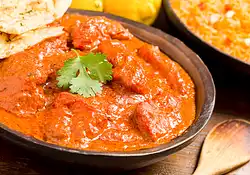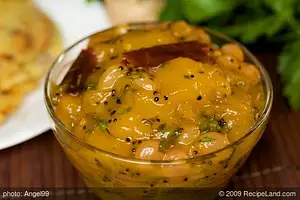Greek yogurt
About the ingredient greek yogurt. Including 48 recipes with greek yogurt, nutrition data, and where to find it.

Contents
What is greek yogurt?
Strained yoghurt, yoghurt cheese, labneh/labaneh, dahi, or more commonly Greek yoghurt, is yoghurt which has been strained in a cloth or paper bag or filter, traditionally made of muslin, to remove the whey, giving a consistency between that of yoghurt and cheese, while preserving yoghurt's distinctive sour taste.
Like many yoghurts, strained yoghurt is often made from milk which has been enriched by boiling off some of the water content, or by adding extra butterfat and powdered milk.
Strained yoghurt is a traditional food in the Middle East and South Asia, where it is often used in cooking, as it is high enough in fat not to curdle at higher temperatures. It is used in both cooked and raw, savoury and sweet dishes.
**Strained yoghurt is used in Greek food mostly as the base for tzatziki dip and as a dessert, where honey, sour cherry syrup, or spoon sweets are often served on top.
A few savoury Greek dishes use strained yoghurt as well. In Greece, strained yoghurt, like yoghurt in general, is traditionally made from sheep's milk. More recently, cow's milk is often used, especially in industrial production.
Nutrition
Nutrition Facts
Serving Size 1 cup (8 fl oz) (245g)Where found
Greek yogurt is usually found in the dairy section or aisle of the grocery store or supermarket.
Food group
Greek yogurt is a member of the Dairy and Egg Products US Department of Agriculture nutritional food group.
How much does greek yogurt weigh?
| Amount | Weight |
|---|---|
| 1 cup (8 fl oz) | 245 grams |
| 1 container (8 oz) | 227 grams |
| ½ container (4 oz) | 113 grams |
Related
Dairy and Egg Products
| In Chinese: | 希腊酸奶 | |
| British (UK) term: | greek yoghurt | |
| en français: | yaourt grec | |
| en español: | yogur griego |
Recipes using greek yogurt
There are 48 recipes that contain this ingredient.

Olive & White Mushroom Soup with 3-colors Fusilli
Once upon a time I was reading a magazine article about good cooking. The journalist tried to convince me not to use some combinations of ingredients. One of the "banned" combinations mentioned was green and black olives. And so this soup was born to enjoy me.

Beet Raita
:)

Beets, Chorizo & Pomegranate Braise with Cilantro Salsa
This delicious and well-balanced one pot meal will for sure satisfy everyone around the dinner table with all the yumminess and goodness.

Easy Dill Tzatziki
I put it on lettuce, eat it with pita chips, or serve it with meat. Always have some plump kalamatas on hand when eating it. So delicious to dunk them in the sauce.

Earth Family Roasted Garlic Pineapple Dip
Best appetizer to serve your guests at a party!

Quick & Easy Cucumber Raita
Cucumber raita is one common side-dish in Indian meal. Its refreshing and creamy taste brings a wonderful balance to the always-spicy main course. This easy and tasty cucumber raita takes on time to make.

Cookie Dough Pops
Egg free, delish cookie dough in the form of pops. Dipped in your favorite chocolate.

Baked Fish & Chips
These baked fish and chips have much less fat and calories than deep-fried ones, but it still tastes delicious, and this time you don't have to feel guilty about it.

Cucumber Raita
Eat with Indian or Lebonese style flat breads. Great as a side with barbequed lamb.

Lemony Strawberry Yogurt Cake with Lemon Glaze
You can't believe how delicious and moist this cake comes out, and best of all is that the cake is made with mostly whole wheat flour, applesauce and yogurt, then glazed with a thin layer of lemony icing. Looks so appealing and tastes even better!

Tandoori Spiced Chicken Breast with Grilled Tomato Jam & Herbed Yogurt Sauce
Absolutely worth the effort of preparation. The chicken tasted so delicious and packed with flavor. No need to order take-out from now on. This homemade tandoori chicken is as yummy as the restaurant one.

Chicken Tikka Masala (Main)
Traditional Indian dish of roasted chunks of chicken in a spicy sauce. The chicken is a very good source of lean protein, while the sauce provides important nutrients such as vitamins A and C as well as calcium.

Custard Peach Pie
This custard peach pie is a great way to use seasonal peaches. The custard is creamy and sweet, and the pecans in the crust and topping are a yummy addition. It’s hard to resist this delicious treat!

Chocolate Pumpkin Layered Cheesecake Bars
Had some pumpkin puree and cream cheese on hand, wondering if I could make a dessert that had these two ingredients and chocolate. Found some recipes that almost fit my thoughts, then combined my own ideas, here these delicious cheesecake bars are. They were absolutely delightful and only lasted a few hours...

Chicken Souvlaki with Tzatziki Sauce
Serve these kabobs as an appetizer with the sauce for dipping, or as sandwiches. Slather the sauce on warmed pita and place the chicken in the pockets along with sliced tomatoes and red onion.

Blueberry Whole Wheat Danish Cheese Cake
Blueberries, Danish and cheesecake are all in one bite, life is good! The cake is made with 100% whole wheat flour, applesauce and olive oil, and they are all good for you. Having one slice or two for breakfast with the morning coffee sounds like a good idea to me :)

Butternut Squash & Yam Casserole
This casserole was scrumptious, the butternut squash and the sweet potatoes turned out soft, sweet and full of flavor; burglar gave the meaty texture and soaked all the delicious flavor; tomato, red wine and stock made a delicious base for this casserole.

Beet Pancakes with Yogurt Dill Sauce
This is an excellent way to prepare beets. Reminiscent of potato pancakes, shredded beets and carrots are mixed with eggs and then cooked in a skillet until crispy on the outside. The earthy sweetness of the beets go perfectly with the creamy yogurt dill sauce, simply delicious!

Chocolate Fudge Bundt Cake with Raspberry-Cream Cheese Filling & Chocolate Ganache
This is not your classic bundt cake that's packed with not-so-good-for-you ingredients. The cake is made with 100% whole wheat flour, grapeseed oil, Greek yogurt, low-fat cream cheese, and fresh raspberries. The ganache doesn't have any butter or cream, it contains cocoa powder, honey, grapeseed oil and Greek yogurt. Super chocolaty, fudgy, moist and packed with goodness.

Chocolate Fudge Bundt Cake with Raspberry-Cream Cheese Filling & Chocolate Ganache
This is not your classic bundt cake that's packed with not-so-good-for-you ingredients. The cake is made with 100% whole wheat flour, grapeseed oil, Greek yogurt, low-fat cream cheese, and fresh raspberries. The ganache doesn't have any butter or cream, it contains cocoa powder, honey, grapeseed oil and Greek yogurt. Super chocolaty, fudgy, moist and packed with goodness.

Alpine Peppered Pineapple with Wild Fruit Yoghurt
A dessert made from pineapple with Alpine Pepper, and served with a side of wild fruit yoghurt.

Orange, Passionfruit & Yogurt Cupcakes
Deliciously moist cupcakes packed with tempting flavors. These go splendidly with a cream cheese frosting!








